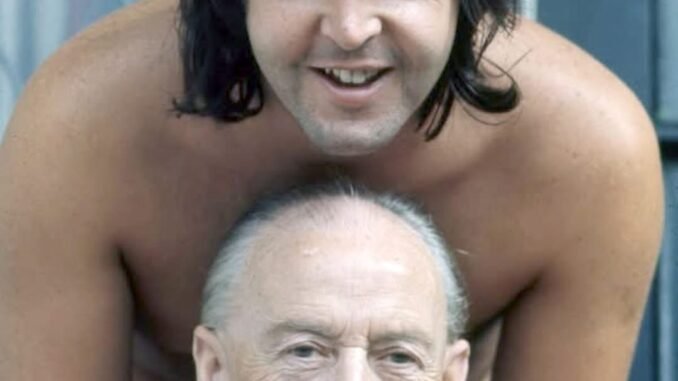
PAUL & JAMES 💙💙
(Paul McCartney and his father, James McCartney)
Long before the world ever heard the opening chords of “Yesterday” or sang along to “Hey Jude,” there was a little boy in Liverpool sitting at a family piano, watching his father’s hands glide over the keys. That boy, of course, was Paul McCartney. And the man who first opened the doors of music to him was his father, James “Jim” McCartney—a warm, steady presence whose own passion for music shaped the future of one of the most gifted songwriters in history.
Jim McCartney was born in 1902 and grew up at a time when music was a family affair. Long before television, people gathered around pianos, gramophones, or community bands for entertainment. Jim had a deep love of melody and rhythm. He never became a famous performer, but he kept a small treasure trove of 78 rpm records at home, each one a portal to a different sound. On evenings after work, he would play them for his family or, better still, sit down at the piano and bring those songs to life with his own hands. These weren’t just notes; they were memories, little musical “party pieces” from his youth that he shared with his sons.
Paul often spoke about how those early experiences shaped his ears. Jim didn’t merely play tunes; he explained them. When a song came on the radio, he would lean in and say, “Listen there, that’s the trumpet,” or, “Hear the harmony between those instruments?” It was a kind of informal music education—without textbooks, without pressure. Through those quiet, thoughtful lessons, Jim taught his children to hear music in layers. For young Paul, that was magical. Long before he met John Lennon or learned a single guitar chord, he was developing a deep understanding of how instruments could weave together.
Jim also loved local brass band concerts, a popular entertainment in Liverpool’s parks and halls. He would take Paul and his brother Michael along, pointing out the flugelhorns, cornets, trombones, and the way they created harmony. Paul later said that those brass band sounds stayed with him, bubbling up years later in Beatles arrangements where French horns, trumpets, and strings appear with a confidence that seems effortless. To the world, The Beatles seemed to leap into innovation—but to Paul, many of those ideas went right back to those Sunday outings with his dad.
At home, Jim encouraged music in every way he could. He never forced Paul to practice, but he kept the family upright piano in tune and ready. One day, as a teenager, Paul sat there idly playing and began to shape a tune that would, years later, become “When I’m Sixty-Four.” He was barely in his teens when he wrote it, long before The Beatles existed. The lyrics came much later, but the melody—playful and nostalgic—was born on that old piano under the watchful eye of a father who believed music should be part of life. When The Beatles eventually recorded the song for Sgt. Pepper’s Lonely Hearts Club Band, Paul couldn’t help but think of his dad, who was indeed in his sixties by then. It was as much a tribute as it was a song.
The McCartney household in those post‑war years was not wealthy, but it was rich in creativity and warmth. Jim had been widowed when Paul was just 14, after Mary McCartney died suddenly of cancer. In that difficult time, Jim’s steady encouragement meant even more. He kept the family’s spirits alive through music, humor, and a belief that his boys could do something extraordinary if they put their hearts into it. It’s easy to see why Paul would later gravitate to the camaraderie of a band—he had grown up in a home where music was something you shared.
Years later, when Beatlemania swept the world, Jim remained a proud yet humble figure. He was known to clip newspaper articles about Paul and send them to relatives, but he never tried to steal the spotlight. Instead, he cheered from the sidelines, happy that the small seeds he’d planted in his living room had blossomed into something magnificent. In interviews, Paul has often recalled Jim’s encouragement as crucial to his development—not just technically, but emotionally. “He taught me how to listen,” Paul once said. “He gave me an idea of harmony that later helped me with John.”
The bond between Paul and Jim McCartney is a reminder that behind every great artist there is often someone quietly nurturing them, someone who believes in their potential long before the rest of the world does. Jim didn’t teach Paul every chord he would ever know, but he gave him something even more important: a love of music, a curiosity for sound, and the confidence to explore. Without those early lessons at the piano, the musical landscape of the 20th century might look very different.
So when we celebrate Paul McCartney, we also celebrate James McCartney—the father with a stack of 78s, a head full of tunes, and a heart big enough to share them. In a very real way, the melodies we all hum today began in that small Liverpool home, with a father and son sitting side by side, discovering music together.
💙 PAUL & JAMES 💙
A legacy written in notes, carried across generations, and still echoing every time we hear a Beatles song.
Leave a Reply